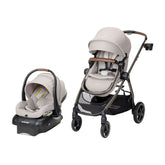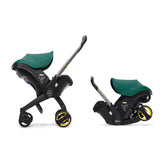Writing a Birth Plan? Get Smart Tips & Helpful Templates

The ultimate goal for any birth plan is the well-being of both the mother and the baby. While it's important to envision how you want your child's birth to unfold, it's also essential to maintain a reasonable level of flexibility, as things may not always go exactly as planned. The primary focus should be on ensuring a safe delivery for your precious little one. Think of your birth plan as a valuable tool to engage in meaningful discussions with your healthcare providers, including your doctor and partner, to address important details and receive the necessary support and care.
If you’ve been trying to figure out how to create a birth plan for baby, we can help! In this article, we’ve put together a guide that covers many of the basic issues you’ll want to address in your birth plan and how it can help you prepare for the big day. We’ve also included links to a few fantastic birth plan templates to help you get the ball rolling.
What Is A Birth Plan?
A birth plan is a written document that outlines the desires and goals of expectant parents for various aspects of the labor and delivery process. It includes your ideal scenario for how you envision the birthing experience if everything goes according to plan. While a birth plan includes personal preferences, it also considers practicality and the resources available at the healthcare provider's facility, as not all requests may be feasible or accommodated. Some healthcare providers may routinely ask parents-to-be to fill out a birth plan, while others are open to fulfilling the request if asked.
Developing Your Birth Plan
Writing a birth plan is a personal and individualized process with no strict rules or guidelines. Each person has different preferences and expectations for their birth experience, taking into account their unique pregnancy profile and history. Some birth plans may be concise, focusing on essential aspects, while others may be highly detailed. Whether you’re trying to figure out how to create a natural birth plan or need to incorporate accommodations for a planned C-section, there’s really no right or wrong way to do it as long as it reflects the specific needs and desires of the person giving birth.

1. Gather information.
Gather all the essential information about the routine policies and procedures related to maternal care at your chosen birth setting. If you come across any policy or procedure that you don’t agree with, it's important to have a discussion with your healthcare provider. As you become more informed about the childbirth process, you’ll likely identify specific details you wish to incorporate into your birth plan.
Consider creating separate pages for an uncomplicated birth/postpartum and potential complications in your birth plan. Take the time to address the following questions suggested by the American Pregnancy Association, understanding that not all may be relevant to your situation:
- Who do you want present during the birth?
- Do you desire the support of a doula?
- Will there be other children/siblings present?
- Do you wish to delay cord clamping?
- Are you planning immediate skin-to-skin contact with your baby?
- Do you want to initiate breastfeeding right after birth?
- What are your preferences regarding mobility during labor? Do you prefer staying in bed or having the freedom to move around?
- Which activities or positions do you intend to use during labor (e.g., walking, standing, squatting, hands and knees)?
- Is there a specific birthing position you prefer?
- How do you plan to manage pain? (e.g., massage, hot and cold packs, relaxation techniques, medication)
- How do you feel about fetal monitoring?
- What are your hydration preferences? (e.g., sips of drinks, ice chips, IV fluids)
- Are you open to pain medication? If so, do you have any preferences?
- Are you willing to consider an episiotomy, or do you have measures in place to avoid one?
- What are your preferences for your baby's care? (e.g., feeding schedule, sleeping arrangements)
- Would you like a routine IV, a heparin/saline block, or neither?
- Do you want to wear your own clothing during labor?
- Would you like to have music playing and focal points in the birthing environment?
- Do you plan to use the tub or shower for pain relief?
- For home and birth center births, what are your plans for emergency hospital transport?
- If a cesarean delivery becomes necessary, do you have any specific requests?
Addressing these questions will help you tailor your birth plan to your unique needs and preferences.
2. Talk with your doctor or midwife.
Healthcare providers typically follow a set routine and prioritize what is best for the birth. It's important to understand that your healthcare provider may have varying levels of receptiveness to your ideas, as they may perceive certain requests as demanding or potentially increasing risks.
Considering the unique nature of each birth and the different interpretations of a "normal" birth, it can be helpful to frame what you want using terms like "birth preferences," "our wishes for childbirth," "as long as birth progresses normally," or "unless there is an emergency." To receive guidance and suggestions, schedule an appointment with the labor and birth department at your chosen hospital or birthing center to review your birth plan.
If possible, ask to spend time in an unoccupied birthing or labor room to familiarize yourself with the environment and determine if there are any additional items you may want to include in your packing list, such as extra pillows, pictures, or music. This will help build your confidence in both your birth plan and your chosen birth location.
3. Stay focused and calm by prepping for the unexpected.
A birth plan can provide a sense of confidence and control during childbirth, as it helps you stay focused and calm, even in the face of unexpected events. It's important to plan for the unexpected by incorporating phrases such as "If a cesarean becomes necessary..." into your birth plan. If you ever feel pressured to make a decision you're uncertain about during labor, you can ask if it's an emergency and request more information and time to consider your options.

4. Try to stay positive
When creating your birth plan, maintain a positive focus by emphasizing what you do want rather than what you don't want. Incorporate phrases like "we hope to," "we plan to," or "we anticipate." Avoid negative phrasing, such as "we don't want" or "we want to avoid." Here are a few examples:
- "Regarding pain management, I am knowledgeable about the available options and will request pain medications if necessary."
- "To protect the perineum, I am actively preparing by practicing squatting, doing Kegel exercises, and perineal massage. I would appreciate guidance on when to push and when to pause, allowing the perineum to stretch."
- "After the birth, my hope is to have immediate skin-to-skin contact with the baby. I kindly request that the baby's evaluation be conducted while on my abdomen and both of us covered by a warm blanket, unless there are exceptional circumstances.
Birth Plan Templates
Looking for a downloadable birth plan template? Check out this one from the American College of Obstetricians and Gynecologists. Some parents also like developing a visual birth plan. This one-page document helps give your providers a quick overview of the type of birth you want to have. Looking for help on how to create a visual birth plan? Visit http://www.visualbirthplanbuilder.com/ and tap on birth preference icons to create your own visual birth plan in seconds.
The Bottom Line on Writing a Birth Plan
Creating a birth plan in advance can provide you with a sense of readiness and enable you to communicate your preferences during labor and delivery. However, it's important to remember that a birth plan is a written agreement, not a binding contract, between you and your healthcare provider. While it's highly likely that your plan can be followed as you've outlined it, there is always a chance that circumstances may require adjustments in the moment. That's why flexibility is the key to a successful birth plan. Childbirth is unpredictable, and even the most well-thought-out plans can deviate from your expectations.









